The Design Museum’s latest exhibition explores a century of swimwear, culture and design, revealing how our relationship with water has shaped everything from fashion to public space, writes Sarah Simpkin
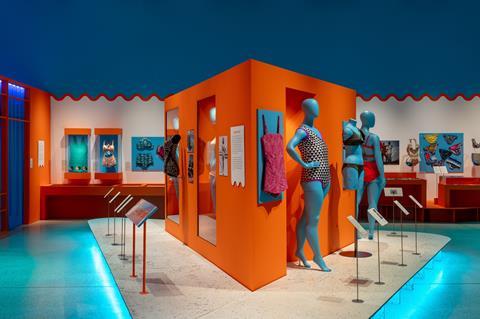
The Design Museum’s new show, Splash! A Century of Swimming and Style, curated by fashion historian Amber Butchart, gives a lot of space to the tiniest of outfits. Visitors can see, together for the first time, Pamela Anderson’s Baywatch swimsuit, one of diver Tom Daley’s knitted jumpers, and writer Roger Deakin’s Speedos.
Swimming is a huge subject to do justice to, particularly when our relationship with the water can be so personal. The exhibition narrows its focus slightly to “the last hundred years, through the lens of design”, but by necessity, that’s a wide fisheye lens. It charts a social history of swimming through fashion, touching on graphic, product, infrastructure and spatial design. The result is an engaging, if slightly surface skim over the architecture of pools and swimming spaces, which I was hoping to see more of. An enjoyable jumping-off point rather than a deep dive.
Architects ScottWhitbyStudio, no strangers to unusual commissions, had the brief of designing the show, including the cabinet for Pamela Anderson’s skimpy red swimsuit. It’s nicely done, illuminated and held aloft like a sacred relic, but without a mannequin, does look a bit like a shopping bag. The emphasis is on fashion; I remember Anderson’s character, C.J., doing a lot of slow-motion running, but swimming, not so much. Presented here as pop culture memorabilia, next to a James Bond-inspired terry towelling shorts suit, you’d think tastes had changed since Saturday afternoon TV in the nineties, and yet we’re back to primetime Gladiators, so perhaps not.
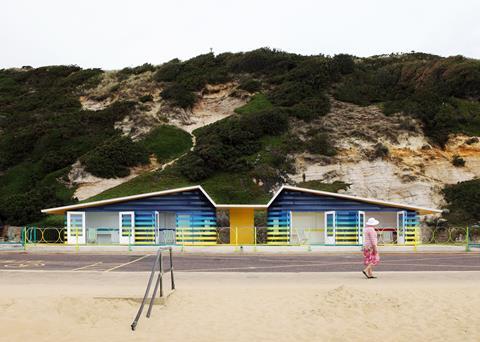
The exhibition flows through three zones: pool, lido and open water. Each has a plinth made from waste plastic, based on a scale model that represents the London Aquatics Centre, the Jubilee Pool in Penzance, and the coastline of southern England respectively. Walls and fittings are painted bright aquamarine, lifebuoy orange and seaweed green, subdued by vaguely underwater lighting. The signs are cut from a biodegradable paper stock made from algae in the Venice Lagoon, selected by the exhibition’s graphic designer Mark El-khatib.
On show is the first bikini from 1946, designed by Louis Réard and declared “sinful” by the Vatican at the time. It premiered in Paris just days after the US nuclear test at Bikini Atoll in the Marshall Islands, getting its name from this shock of the atomic age. It’s one of several items on loan from the BikiniARTmuseum, the international museum of bathing culture in the landlocked town of Bad Rappenau, south-west Germany.
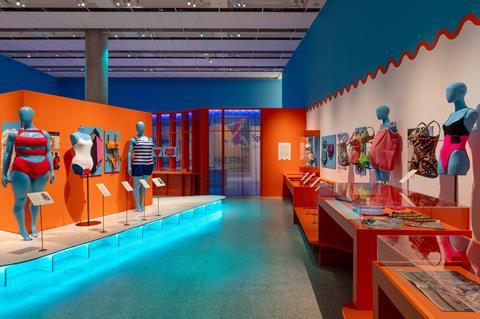
Splash! is more than a parade of swimwear. These outfits mirror wider changes over the past century, “whether that’s around issues of bodily autonomy and agency, or how we spend our leisure time”, explains Butchart. It explores themes of self-expression, religion, sexuality, access, sport, the British seaside and the package holiday, wild swimming, camaraderie and pollution, all that plus more obscure sections on mermaids and outdoor pools in Hong Kong.
It’s pop, it’s fun; Butchart’s own love of sea swimming and fashion make for engaging, informative displays. But there’s also a sense of other stories to be told.
The vitrine dedicated to environmentalist and writer Roger Deakin, for example, distils his contribution to the wild swimming movement to a stack of A4 paper (his 1998 Waterlog manuscript), a couple of swimming photos and a pair of trunks. What do I get from seeing his black Speedos? Not much about the complex character in Patrick Barkham’s recent biography.
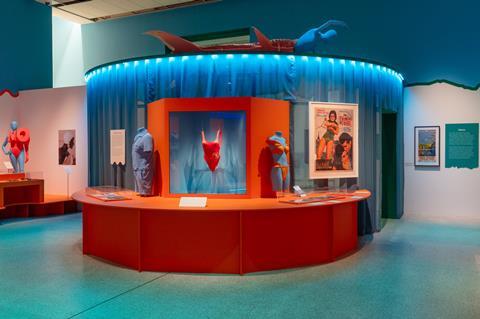
This is a feeling I keep getting as I walk around more of these experiments in stretchy fabric. There’s a devotion behind these stories that’s difficult to express in objects, whether honed by gruelling training or experiencing nature. In her introduction to Waterlog, Olivia Laing imagines how Deakin would have reacted to the current state of our waterways. “He would have been enraged, I think. He would have been standing outside parliament in his black Speedos, bellowing through a megaphone about the pleasure and powers of a water cure.”
Some of the most touching exhibits are the films where swimmers speak for themselves. “The sea embraces you,” says one of the Haenyeo in a documentary about the free-diving fisherwomen of Jeju, South Korea. The next film, Beyond the Blue, follows Swim Dem Crew, who promote swimming in underrepresented groups – 95% of Black adults in the UK don’t swim regularly, and according to Sport England, almost a third of all children leave primary school unable to swim 25 metres.
For each place full of life, there’s an absence. ScottWhitby’s restoration of Penzance’s Jubilee Pool, built in 1935 and now the UK’s first geothermally heated saltwater lido, is rightly celebrated. But a few weeks ago, I visited the shell of Tynemouth’s grand 1920s sea pool. It’s still waiting for its renovation, the cost of which has reportedly doubled to £10 million.
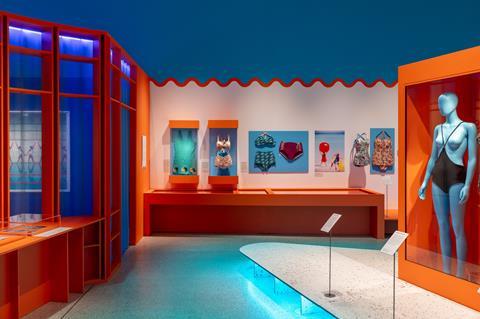
Similarly, the London Aquatics Centre by Zaha Hadid Architects remains a legacy triumph of the 2012 Olympics. We hear from a coach how motivating students find it to swim in the same waters as Rebecca Adlington and Michael Phelps. Yet south of the river, the Grade II-listed Crystal Palace National Sports Centre’s 50-metre competition pool and diving pool remain empty and cracked, closed since 2020. Mayor Sadiq Khan has pledged to fund a five-year restoration, taking it out of action for at least a decade. A generation of young people won’t get to dive there, with repercussions for the sport – its high boards have launched the careers of many Team GB athletes (and actor Jason Statham).
Public pools are closing at a rate that disproportionately affects the most deprived areas of the country. The exhibition cites 1980s privatisation and 2010s austerity, phenomena intensified in recent years by pandemic closures, council budget pressures and rising energy costs. It’s hard to make an accurate financial case, but Swim England put the social value of swimming at £2.4bn, through its community, physical and mental health benefits. It feels like a finger-in-the-air figure, but Splash! makes this argument well, if subtly.
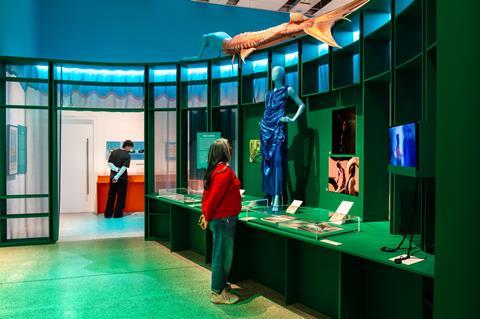
There’s no mention of the Embassy Gardens sky pool at Nine Elms, which is an aquatic cultural moment of sorts, if only as a metaphor for swimming becoming increasingly out of reach for too many.
Leaving the exhibition, I wondered about the failure of evolution that had taken us from poolside pyjamas to the Dryrobe. But my main thought, bobbing to the surface like a child’s plaster I couldn’t escape, was that I wanted to go swimming. Now. Like Deakin, “to experience the world through the eyes of an otter.” But in my south London lido, with its resident goose.
>> Also read: Unknown Works unveils Science Museum gallery space
>> Also read: An Atlas of Es Devlin: ‘The impact of her work can last a lifetime’
Postscript
Splash! A Century of Swimming and Style is at the Design Museum until 17 August.
Sarah Simpkin is a writer and communications consultant.



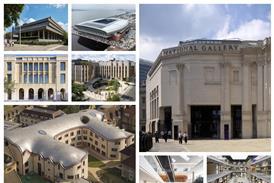












1 Readers' comment